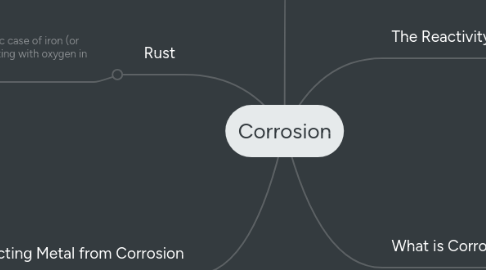
1. Protecting Metal from Corrosion
1.1. Sacrificial Protection
1.1.1. This is when you attach blocks of magnesium or zinc on iron. Because magnesium is more reactive than iron, it corrodes first, leaving the iron intact. Eventually the magnesium has to be replaced because it will have completely corroded away.
1.2. Electroplating
1.2.1. This process deposits a thin layer of metal on the object being protected.
1.3. Galvanising
1.3.1. This is when a zinc layer stops oxygen/water or salt from attacking iron. An advantage is that a scratch will still slow corrosion (as Zn is higher in the series) via sacrificial protection.
1.4. Painting / Greasing
1.4.1. Using paint or grease physically stops oxygen/water/salt from reaching the metal. The disadvantage of this method is that it must be constantly renewed.
2. Rust
2.1. The specific case of iron (or steel) reacting with oxygen in water.
2.1.1. iron + oxygen → iron oxide.
3. What is Corrosion?
3.1. The chemical deterioration of a material, usually a metal or metal alloy, is called corrosion
3.2. The most common causes of corrosion are contact with water and oxygen, though other substances in the earth and in the atmosphere can also cause corrosion.
4. The Reactivity Series
4.1. The more reactive a metal, the more likely it is to corrode.
4.1.1. sodium
4.1.2. calcium
4.1.3. magnesium
4.1.4. aluminium
4.1.5. zinc
4.1.6. iron
4.1.7. lead
4.1.8. hydrogen
4.1.9. copper

